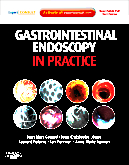|
|
|
| |
 |
|
|

|
-
推薦指數:





|
|
- 內容介紹
|
Gastrointestinal Endoscopy in Practice
Expert Consult: Online and Print
By Jean Marc Canard, MD, Jean-Christophe Letard, MD, Laurent Palazzo, MD, Ian Penman, BSc MD FRCP Edin and Anne Marie Lennon, MD, MRCPI, PhD
Hardcover Reference
492 Pages
Trim Size: 7 3/4 X 9 7/16 in
Imprint: Churchill Livingstone
ISBN: 978-0-7020-3128-1
Copyright: 2011
Key Features
Practical approach taken throughout, with step by step guides to performing procedures
Clear algorithms included throughout to summarize the clinical decision making process.
Detailed coverage of two specific procedures: endosonography and ERCP that provides an ideal resource for trainee and established endoscopists.
Outstanding full color illustrations incorporated throughout. Provides an accurate visual guide to the endoscopic approaches and techniques under discussion
World class team of international expert contributing authors from Europe and North America. Therapeutic options and preferred methods of treatment are drawn from all over the world and not just the US.
New to This Edition
Endosonography and ERCP
Radiofrequency Ablation for early Barrett's neoplasia
Advanced imaging techniques: confocal endomicroscopy, autofluorescence, narrow band imaging, magnification endoscopy.
Endoscopic mucosal resection techniques
Small bowel endoscopy - capsule and enteroscopy
Endoscopy and obesity
1 Introduction to endoscopy
1.1 Anatomy of an endoscope
1.2 Electronic video endoscopy
1.3 Endoscopic accessories
1.4 Electrosurgical generators: procedures and precautions
1.5 Organizational structure of an endoscopy unit
1.6 Gastrointestinal endoscopy training
1.7 Endoscopy nurses
1.8 Patient information
1.9 Medicolegal aspects of endoscopy
1.10 Cleaning, disinfection, sterilization, and storage of endoscopy materials
1.11 Gastrointestinal biopsies and histology
2 Preparation for Endoscopy
2.1 Management of patients on antithrombotic therapy prior to gastrointestinal endoscopy
2.2 Antibiotic prophylaxis
2.3 Sedation
2.4 Chromoendoscopy and tattooing
2.5 Pre-endoscopy checklist
2.6 Endoscopy reports
3 Diagnostic Upper Endoscopy
4 Diagnostic Colonoscopy
5 Small Bowel Endoscopy: Indications and Technique
5.1 Video capsule endoscopy
5.2 Enteroscopy: indications and techniques
6 Advanced Imaging
6.1 Confocal endomicroscopy
6.2 New endoscopic imaging modalities
&' || 'nbsp;
7 Interventional Endoscopy
7.1 Stricture dilation
7.2 Emergency endoscopy in benign gastrointestinal obstruction
7.3 Esophageal, duodenal and colorectal stenting
7.4 Argon plasma coagulation
7.5 Management of ingested foreign bodies
7.6 Endoscopy in obesity
7.7 Polypectomy
7.8 Endoscopic treatment of upper gastrointestinal hemorrhage in patients with
peptic ulcer
7.9 Endoscopic treatment of upper gastrointestinal hemorrhage secondary to
portal hypertension
7.10. Endoscopic treatment of non-variceal non-ulcer gastrointestinal hemorrhage
7.11 Percutaneous endoscopic gastrostomy
7.12. Endoscopic mucosal resection
7.13 Endoscopic pH monitoring and treatment of gastroesophageal reflux disease
7.14 Ablative therapies for esophageal neoplasia
8 Complications of Gastrointestinal Endoscopy
9 Endosonography
&' || 'nbsp;
10 Endoscopic Retrograde Cholangiopancreatography
10.1 Introduction
10.2 Indications for diagnostic ERCP
10.3 Drugs used in ERCP
10.4 Equipment
10.5 Checklist before starting an ERCP
10.6 Basic ERCP technique
10.7 Cytology, biopsies, and biochemical analysis
10.8 Pancreaticobiliary anatomy
10.9 ERCP imaging technique
10.10 Abnormal imaging: classification and etiology
10.11 Endoscopic sphincterotomy
10.12 Biliary and pancreatic stone extraction techniques
10.13 Biliary and pancreatic stents: insertion techniques
10.14 Biliary and pancreatic balloon dilation
10.15 Endoscopic ampullectomy
10.16 Photodynamic therapy
10.17 Cholangioscopy
10.18 Sphincter of Oddi manometry
10.19 Nasobiliary drain insertion
10.20 Complications of ERCP
|
|
|

